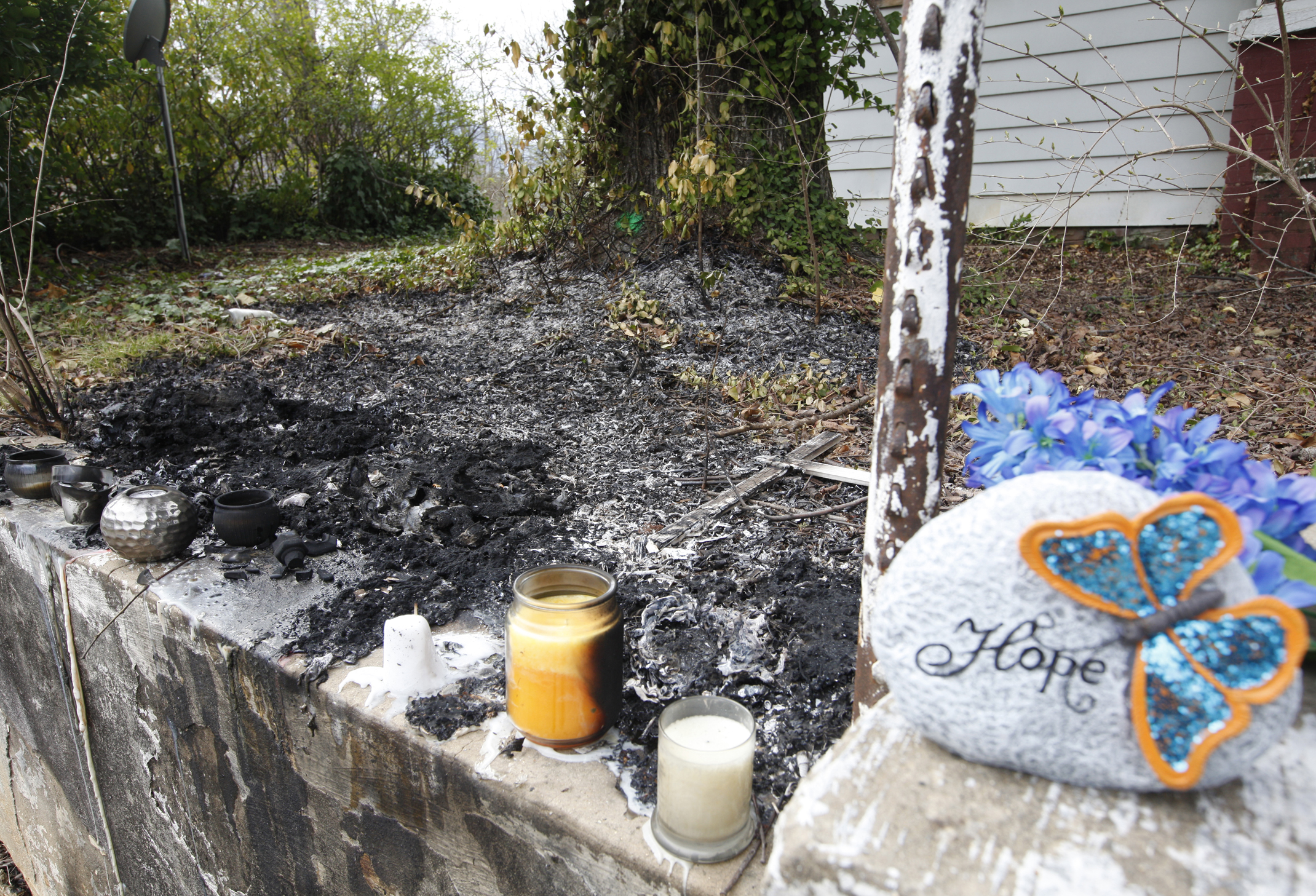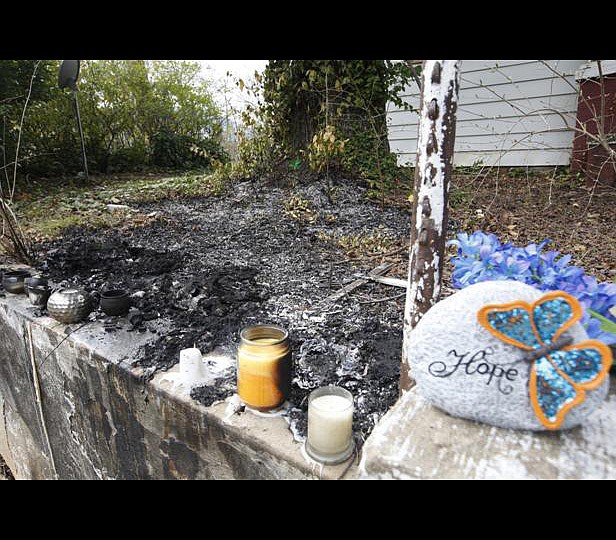 Intact memorial stones sit on a retaining wall next to the burned remains of candles, flowers, and Teddy bears Saturday, what's left of a memorial for a 16-year-old Howard School student shot to death at a vacant home along Carr Street last week. It wasn't clear whether a candle somehow sparked the blaze or someone deliberately burned it.
Intact memorial stones sit on a retaining wall next to the burned remains of candles, flowers, and Teddy bears Saturday, what's left of a memorial for a 16-year-old Howard School student shot to death at a vacant home along Carr Street last week. It wasn't clear whether a candle somehow sparked the blaze or someone deliberately burned it.The naysayers may have been right.
When officials launched the city's single largest effort to squelch youth gangs last year, many wondered whether it would last.
They had seen programs come and go. Politicians forget. Grants expire. Priorities change. And yet kids were still killing each other on the streets of Chattanooga.
Now, six months after a 173-page report documented the depths of our gang problem and with a new administration waiting in the wings, the future of the city's Gang Task Force seems to hang in the balance.
Mayor-elect Andy Berke and a reshaped City Council will bring new ideas and possibly shifting goals and priorities. Berke has acknowledged as much.
In his campaign, Berke made statements like: "The crime rate is unacceptable, and we will change it." And: "We're getting pretty hung up on this 'gang' word."
On Friday he again hinted that he may change the city's emphasis on gang violence.
"I appreciate the focus that we've had on gang violence in our city," he said in an interview. "My focus is going to be broader."
Domestic violence needs more attention, he said. So does property crime.
Meanwhile, the bullets still fly.
The same day voters picked Berke as their next leader, a 16-year-old boy was shot dead near downtown, a block from his school. Police say both shooter and victim were gang members.
Just a day before, the first-degree murder case against two documented gang members fell apart in court when none of the estimated 20 eyewitnesses would say they saw the shooter. It's a common problem, prosecutors say.
Berke doesn't question whether Chattanooga has a gang problem, but he said he heard a lot of criticism of the current administration's approach.
And some big support for Berke's campaign came from the Lebovitz family, whose CBL & Associates balked when the gang assessment identified Hamilton Place mall as a "gang hotspot." Alison Lebovitz is a member of Berke's transition team.
Ternae Jordan, the Mount Canaan Baptist pastor who in 2007 started a different effort to combat gangs, also is a transition team member.
So is Al Chapman, who headed another anti-crime program under the current administration.
Trying to stop such a broad, deep-seated problem as gang violence in Chattanooga is like trying to outrun a bullet. Yet, despite the enormity of the challenge, some people already wonder if the task force is delivering results.
"I think time for studies is certainly over. I don't know how many more teenagers need to be shot and killed before we take action," said Chris Anderson, who last week was elected to a City Council seat that represents much of downtown. "People in my district are afraid to sleep at night, in their own homes. And that's not right."
Others say this gang effort is working, or at least well on its way.
Several observers see this as a crucial time in the city's campaign against gangs. Relationships have been built, groundwork has been laid and programs are just starting to surface with the intention of preventing violence and influencing kids' lives.
"It's still early," said Hamilton County Juvenile Judge Suzanne Bailey. "In the 30 years I've been on the bench, I feel this is one of the strongest organizational efforts I've seen in intervening in these kids' lives to combat gang violence."
•••
It's too early to judge the work of the task force on numbers alone. But some of its success can be measured in lives.
Gang Task Force Coordinator Boyd Patterson spends his days running between meetings, mediating and making connections. He's trying to bring together churches, employers, law enforcement agencies and social groups.
For better or worse, the task force, officially called "The Future Is Ours," is an arm of city government. The current mayor and council approved about $500,000 for the task force's first year. To combat the proliferation of gangs, the group has grown from two people to five. And two more will be hired soon.
But Patterson insists their work is more than just talking and pushing papers.
"Every single program that we put together has some impact on the street level," he said. "It requires us to interact at the street level."
There's the 47-year-old grandmother who wanted to be able to read to her grandkids. The task force helped her find a literacy program at a community center.
There's the young man who just needed someone to give him a chance. The task force helped him find part-time employment at a library.
And there was the entrenched gang member who last week approached the task force saying he was fed up with living that lifestyle and wanted better for his own kids. Patterson and others are helping him to find a way out. He has a job interview this week.
Task force leaders have held youth rallies and hosted motivational speakers. They've brought together faith groups to help shrink the literacy gap that too often holds back inner-city blacks and Hispanics. And computer programs that help people learn to read are making their way into the city's recreation centers.
The task force held a prayer vigil and collected money and medical supplies for Keoshia Ford, a 14-year-old who was left paralyzed and bedridden after a stray bullet struck her in the head amid a gang shootout.
The task force recruits felons for workplaces and soon plans to hire a school-based outreach worker to help connect at-risk kids with needed resources. They also will hire an interventionist-- what they call an "interrupter" -- to work the streets.
Some initiatives are grant funded; others are sustained on donations and the task force budget. All those efforts are in addition to police work with investigations, undercover officers and suppression in the inner city.
The comprehensive approach to battling growing gangs wasn't Chattanooga's idea. The system is modeled after the National Gang Center blueprint that has been proven to curb gang influence in cities like Los Angeles, Houston, North Miami Beach, Fla., and Pittsburgh, Pa.
"Even with the best programs hitting on all cylinders there will always be kids in gangs and there will always be kids shooting each other," said Patterson.
"Nothing can completely eradicate street gangs. But it is our responsibility to bring best practices. ... We have to minimize the conditions that lead to it."
•••
Chattanooga's political will follows a predictable pattern. New initiatives follow gunfire, especially when it takes place downtown and children are involved.
The work of a 1988 city study and gang task force didn't last.
Current Mayor Ron Littlefield's administration launched Stop the Madness after a gang shooting in 2006. The city gave the group $200,000, but pulled funding after two years.
"It went along fine for a couple of years. Some members on the council didn't savor it so it was squeezed out of the budget," said Littlefield.
And after receiving $2 million over a decade, the federally backed Weed and Seed program in West Chattanooga lost funding as well. Both initiatives were aimed at curbing crime and gang violence. Police also launched specific efforts, with saturations and holiday roundups like Gangsgiving now commonplace.
A teenage shootout in Coolidge Park in the spring of 2010 and another on Christmas Eve 2011 in the heart of downtown's entertainment district helped provoke the formation of the Gang Task Force.
"I think that what we are doing now has sticking power," Littlefield said.
It's unclear how last week's shooting of a Howard School student near the campus will sway minds and new leaders like Berke.
On Friday, still grieving the loss of his student, Howard Principal Paul Smith said he sees the new mayor moving in a different direction. Berke hasn't discussed gangs at length with Patterson, but even before his campaign the man who would be mayor talked to teachers at Howard about crime.
"He looks at the whole issue," Smith said. "It's deeper than gangs. ... At the same time a kid is killed here (in our neighborhood) another kid is killed by a drunk driver."
"He can't be tied to a facet or one side of town," Smith said.
Still, when kids kill kids, society feels a sense of duty, an obligation to step in, to do something.
Smith shed a tear when talking about Lamunta Williams, Tuesday's shooting victim. Smith said Williams stood out. Yet he was one the Gang Task Force didn't get a chance to reach.
"It's a terrible loss," Smith said.
Outside the abandoned house where Williams was killed, a makeshift memorial has been created by family and friends. Teddy bears and candles sit around a poster filled with handwritten notes.
"RIP Munta."
"RIP Lilcuz."
"I love you cousin."
"I smile cause you in a better place," writes his mother. "Going to miss your smile. Mommy here baby. We gonna c this thru. We gonna make sure they pay."
